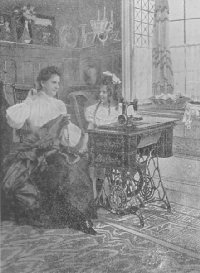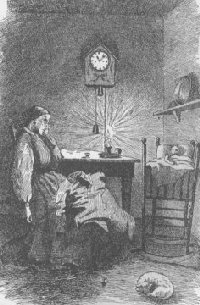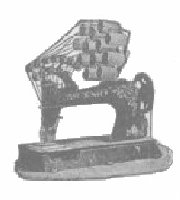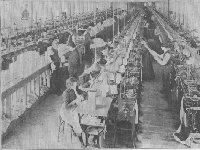In the sewing machine as in many other inventions America leads the world. Not only is this true of the machine used in the family, but of machines used in manufacturing, for stitching all kinds of textile fabrics and leather, including special machines for buttonholes, eyelets, over-seaming, embroidery, etc. The idea of sewing by machinery had been cherished for a hundred years before the first successful machine was made. Passing the records made by Thomas Saint, in 1790, and Duncan in 1804, both of England, and those of Dodge (1818) and Lye (1826), both of the United States, because it does not appear that either of their inventions was of practical use, we find that, in 1830, Barthlemy Thimonnier patented a sewing machine in France, which was so successful that, in 1841, 80 of them, made of wood, were in use for sewing army clothes at a shop in Paris.
In addition to machines of the best type for family sewing, a single manufacturing company makes more than 70 distinct classes, or types, of sewing machines for every stitching process used in manufacture; these classes are fitted with attachments, or devices, for special processes, and there are more than six hundred distinct varieties of Singer machines. There are machines making twelve, or more, seams at once; machines, also, that hemstitch and tuck; machines that ruffle and tuck; machines for stitching books and boots, sewing on buttons and making the buttonholes; in short, the American sewing machine of today stitches everything capable of needle perforation, from lace to leather. This development of special stitching appliances for factory operation has been of tremendous benefit to the world, because it has caused a great reduction in the cost to the consumer of many articles in common use.
Much of the foregoing comment as to the effect of the sewing machine in lightening the task of the mistress of the household, as well as in lessening the expense incurred for clothing the family may properly apply to the results attending the introduction of the knitting machine. The enterprise of knitting by machinery has already attained large proportions.
The modern, upright, rotary knitting machine has two cylinders or heads. Each head generally knits four threads at once, and each thread, or the machinery necessary to knit it, is called a feed. One girl can attend to six cylinders. The needles used are the spring-beard, and they are placed in a mold in pairs, and leaded by having a composition consisting of equal parts of lead and tin poured around them. The gauge is determined by measuring the needles and counting the leads, when set in the cylinder. For instance, 14-gauge has 14 leads, or 28 needles, 3 inches in length, measured on the circumference. A single-cylinder apparatus of 22 inches diameter, 20-gauge, 4 feeds, knitting common hosiery, yarn, cotton and wool mixed, running 45 revolutions, has 920 needles, thus making 165,000 stitches per minute. A 16-inch cylinder, 20-gauge, 4 feeds, cotton yarn, has run 79 revolutions and made 212,532 stitches per minute. Usually, an 18-inch cylinder, 15-inch gauge, is run 45 revolutions; and a table of two heads turns off 160 pounds of knit cloth, per day of 11 hours. THE SEMI-AUTOMATIC PIANO PLAYER |



